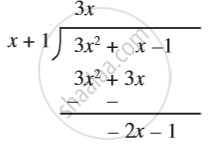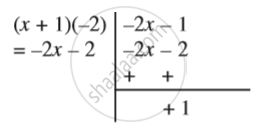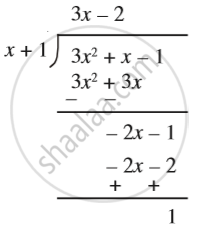Topics
Compound Interest
- Compound Interest as a Repeated Simple Interest Computation with a Growing Principal
- Use of Compound Interest in Computing Amount Over a Period of 2 Or 3-years
- Use of Formula
- Finding CI from the Relation CI = A – P
GST (Goods and Services Tax)
- Sales Tax, Value Added Tax, and Good and Services Tax
- Computation of Tax
- Concept of Discount
- List Price
- Basic Concepts of Profit and Loss
- Basic/Cost Price Including Inverse Cases.
- Selling Price
- Dealer
- Goods and Service Tax (Gst)
- Gst Tax Calculation
- Input Tax Credit (Itc)
Commercial Mathematics
Algebra
Banking
Geometry
Shares and Dividends
Linear Inequations
- Linear Inequations in One Variable
- Solving Algebraically and Writing the Solution in Set Notation Form
- Representation of Solution on the Number Line
Mensuration
- Circumference of a Circle
- Surface Area of a Right Circular Cone
- Surface Area of a Sphere
- Circle - Direct Application Problems Including Inner and Outer Area
- Surface Area of a Right Circular Cone
- Surface Area of a Sphere
- Volume of a Cylinder
- Volume of a Combination of Solids
- Surface Area of Cylinder
Symmetry
Quadratic Equations
- Quadratic Equations
- Solutions of Quadratic Equations by Factorization
- Nature of Roots of a Quadratic Equation
- Equations Reducible to Quadratic Equations
Trigonometry
- Trigonometric Ratios of Complementary Angles
- Trigonometric Identities
- Heights and Distances - Solving 2-D Problems Involving Angles of Elevation and Depression Using Trigonometric Tables
- Trigonometry
Statistics
- Median of Grouped Data
- Graphical Representation of Data as Histograms
- Ogives (Cumulative Frequency Graphs)
- Concepts of Statistics
- Graphical Representation of Data as Histograms
- Graphical Representation of Ogives
- Finding the Mode from the Histogram
- Finding the Mode from the Upper Quartile
- Finding the Mode from the Lower Quartile
- Finding the Median, upper quartile, lower quartile from the Ogive
- Calculation of Lower, Upper, Inter, Semi-Inter Quartile Range
- Concept of Median
- Mean of Grouped Data
- Mean of Ungrouped Data
- Median of Ungrouped Data
- Mode of Ungrouped Data
- Mode of Grouped Data
- Mean of Continuous Distribution
Solving (Simple) Problems (Based on Quadratic Equations)
- Problems Based on Numbers
- Problems Based on Time and Work
- Problems Based on Geometrical Figures
- Problems Based on Distance, Speed and Time
- Problems on C.P. and S.P.
- Miscellaneous Problems
Ratio and Proportion
- Concept of Ratio
- Concept of Proportion
- Componendo and Dividendo Properties
- Alternendo and Invertendo Properties
- Direct Applications
Probability
Factorization
- Factor Theorem
- Remainder Theorem
- Factorising a Polynomial Completely After Obtaining One Factor by Factor Theorem
Matrices
Arithmetic Progression
- Arithmetic Progression - Finding Their General Term
- Sum of First ‘n’ Terms of an Arithmetic Progressions
- Simple Applications of Arithmetic Progression
- Arithmetic mean
- Properties of an Arithmetic Progression
Geometric Progression
- Geometric Progression - Finding Their General Term.
- Geometric Progression - Finding Sum of Their First ‘N’ Terms
- Simple Applications - Geometric Progression
Reflection
- Reflection Examples
- Reflection Concept
- Reflection of a Point in a Line
- Reflection of a Point in the Origin.
- Invariant Points.
Co-ordinate Geometry Distance and Section Formula
- Co-ordinates Expressed as (x,y)
- Distance Formula
- Section Formula
- The Mid-point of a Line Segment (Mid-point Formula)
- Points of Trisection
- Centroid of a Triangle
Co-ordinate Geometry Equation of a Line
- Slope of a Line
- Concept of Slope
- Equation of a Line
- Various Forms of Straight Lines
- General Equation of a Line
- Slope – Intercept Form
- Two - Point Form
- Geometric Understanding of ‘m’ as Slope Or Gradient Or tanθ Where θ Is the Angle the Line Makes with the Positive Direction of the x Axis
- Geometric Understanding of c as the y-intercept Or the Ordinate of the Point Where the Line Intercepts the y Axis Or the Point on the Line Where x=0
- Conditions for Two Lines to Be Parallel Or Perpendicular
- Simple Applications of All Co-ordinate Geometry.
- Collinearity of Three Points
Similarity
- Similarity of Triangles
- Axioms of Similarity of Triangles
- Areas of Similar Triangles Are Proportional to the Squares on Corresponding Sides
- Conditions for Similarity of Two Triangles: (Sas, Aa Or Aaa and Sss)
- Basic Proportionality Theorem with Applications
- Relation Between the Areas of Two Triangles
- Similarity as a Size Transformation
- Direct Applications Based on the Above Including Applications to Maps and Models
Loci
Circles
- Concept of Circle
- Areas of Sector and Segment of a Circle
- Tangent Properties - If a Line Touches a Circle and from the Point of Contact, a Chord is Drawn, the Angles Between the Tangent and the Chord Are Respectively Equal to the Angles in the Corresponding Alternate Segments
- Tangent Properties - If a Chord and a Tangent Intersect Externally, Then the Product of the Lengths of Segments of the Chord is Equal to the Square of the Length of the Tangent from the Point of Contact to the Point of Intersection
- Tangent to a Circle
- Number of Tangents from a Point on a Circle
- Chord Properties - a Straight Line Drawn from the Center of a Circle to Bisect a Chord Which is Not a Diameter is at Right Angles to the Chord
- Chord Properties - the Perpendicular to a Chord from the Center Bisects the Chord (Without Proof)
- Theorem: Equal chords of a circle are equidistant from the centre.
- Theorem : The Chords of a Circle Which Are Equidistant from the Centre Are Equal.
- Chord Properties - There is One and Only One Circle that Passes Through Three Given Points Not in a Straight Line
- Arc and Chord Properties - the Angle that an Arc of a Circle Subtends at the Center is Double that Which It Subtends at Any Point on the Remaining Part of the Circle
- Theorem: Angles in the Same Segment of a Circle Are Equal.
- Arc and Chord Properties - Angle in a Semi-circle is a Right Angle
- Arc and Chord Properties - If Two Arcs Subtend Equal Angles at the Center, They Are Equal, and Its Converse
- Arc and Chord Properties - If Two Chords Are Equal, They Cut off Equal Arcs, and Its Converse (Without Proof)
- Arc and Chord Properties - If Two Chords Intersect Internally Or Externally Then the Product of the Lengths of the Segments Are Equal
- Cyclic Properties
- Tangent Properties - If Two Circles Touch, the Point of Contact Lies on the Straight Line Joining Their Centers
Constructions
- Circumscribing and Inscribing a Circle on a Regular Hexagon
- Circumscribing and Inscribing a Circle on a Triangle
- Construction of Tangents to a Circle
- Circumference of a Circle
- Circumscribing and Inscribing Circle on a Quadrilateral
Notes
Let us consider two numbers 15 and 6. You know that when we divide 15 by 6, we get the quotient 2 and remainder 3. We write 15 as 15 = (6 × 2) + 3
Now let us consider an example to see how we can divide a polynomial by any non-zero polynomial.
Divide p(x) by g(x), where p(x) = x + `3x^2` – 1 and g(x) = 1 + x.
Sol- The process of division by means of the following steps:
Step 1 : We write the dividend `x + 3x^2 – 1` and the divisor 1 + x in the standard form, i.e., after arranging the terms in the descending order of their degrees. So, the dividend is `3x^2 + x –1 `and divisor is x + 1.
Step 2 : We divide the first term of the dividend by the first term of the divisor, i.e., we divide `3x^2` by x, and get 3x. This gives us the first term of the quotient.
`(3x^2)/x = 3x` = first term of quotient
Step 3 : We multiply the divisor by the first term of the quotient, and subtract this product from the dividend, i.e., we multiply x + 1 by 3x and subtract the product `3x^2 + 3x` from the dividend `3x^2 + x – 1`. This gives us the remainder as –2x – 1. Fig.

Step 4 : We treat the remainder –2x – 1 as the new dividend. The divisor remains the same. We repeat Step 2 to get the next term of the quotient, i.e., we divide the first term – 2x of the (new) dividend by the first term x of the divisor and obtain – 2. Thus, – 2 is the second term in the quotient.
`(–2x)/x = – 2`
= second term of quotient
New Quotient = 3x – 2
Step 5 : We multiply the divisor by the second term of the quotient and subtract the product from the dividend. That is, we multiply x + 1 by – 2 and subtract the product – 2x – 2 from the dividend – 2x – 1. This gives us 1 as the remainder. Fig.

This process continues till the remainder is 0 or the degree of the new dividend is less than the degree of the divisor. At this stage, this new dividend becomes the remainder and the sum of the quotients gives us the whole quotient.
Step 6 : Thus, the quotient in full is 3x – 2 and the remainder is 1.Fig.

Dividend = (Divisor × Quotient) + Remainder
i.e. ` 3x^2 + x – 1 = (x + 1) (3x – 2) + 1`
Theorem
: Let p(x) be any polynomial of degree greater than or equal to one and let a be any real number. If p(x) is divided by the linear polynomial x – a, then the remainder is p(a).
Proof : Let p(x) be any polynomial with degree greater than or equal to 1. Suppose that when p(x) is divided by x – a, the quotient is q(x) and the remainder is r(x), i.e.,
p(x) = (x – a) q(x) + r(x)
Since the degree of x – a is 1 and the degree of r(x) is less than the degree of x – a, the degree of r(x) = 0. This means that r(x) is a constant, say r.
So, for every value of x, r(x) = r.
Therefore, p(x) = (x – a) q(x) + r
In particular, if x = a, this equation gives us
p(a) = (a – a) q(a) + r = r,
which proves the theorem.
